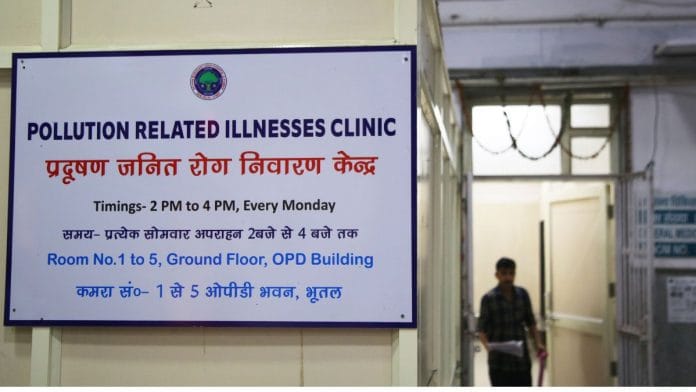New Delhi: Delhi is coughing, but the new pollution clinic at Dr Ram Manohar Lohia Hospital has no patients. Geared with N95 masks, stethoscopes and prescription pads, six doctors occupy three rooms on the ground floor of RML’s main Outpatient Department.
On 6 November, as Delhi’s Air Quality Index shot above 400, a team of doctors from five specialities started a unique experiment. They opened a ‘pollution OPD’ for patients exhibiting symptoms linked to poor air quality. The clinic, they say, is a milestone in understanding pollution and its effects, which extend beyond respiratory illnesses.
“Each year around Diwali, we see a spike in pollution and about a 30 per cent increase in patients – especially in the respiratory, ear-nose-throat (ENT) and eye departments. That is why we started this multidisciplinary OPD,” said Dr Ajay Shukla, medical superintendent at the central government-run hospital.
The new OPD, which operates every Monday from 2 to 4 pm, consists of a specialist each from the departments of respiratory medicine, ENT, ophthalmology, dermatology, and psychiatry.
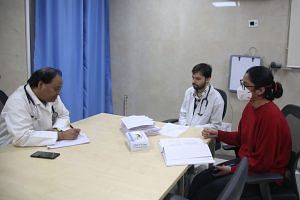
But the experiment is yet to take off.
A new signboard at the entrance of the hospital’s main OPD building announces the launch of the ‘pollution-related illnesses clinic’. Details about this new OPD have also been added to the drop-down menu of RML’s patient registration software. However, no patients have been recorded under it so far.
RML’s 23-member OPD registration staff is trained to recognise and record patients with signs of breathlessness, redness in the eyes and other irritations. “Many times, patients come and tell us about the problems they have but don’t know which OPD to go to. So, we guide them,” says Manoj Kumar, who supervises an OPD registration counter at the hospital. But the process is far from streamlined. Staff seldom refers patients to the pollution OPD. People with skin problems are automatically sent to dermatology, while those with watery eyes to opthalmology. A patient must explicitly state that they’re affected by poor air quality in order to get referred to the pollution clinic.
The doctors behind the experiment are optimistic; they’re sure people will reach out once their OPD becomes “popular”.
The idea is to segregate patients with pollution-related symptoms and consolidate them under this “special OPD”. “They should not be running around to different departments,” says Dr Amit Suri, head of the respiratory medicine wing that is also the nodal department for the pollution OPD.
Multidisciplinary OPD
The day after Diwali, Delhi woke up to an Air Quality Index (AQI) of over 300. The severely contaminated air, loaded with elevated levels of Particulate Matter (PM), drove many breathless people to RML’s Emergency room. The doctors on duty at this chaotic emergency ward point to many patients admitted with respiratory complaints on or after 12 November.
One of them is 70-year-old MS Baburaj. A worker at the RML doctors’ canteen, Baburaj survived a heart attack about a month and a half ago. He was slowly recovering, but on the night of Diwali, his condition worsened. By evening the next day, his neighbour, Sujan Jacob, brought him back to the hospital’s ER.
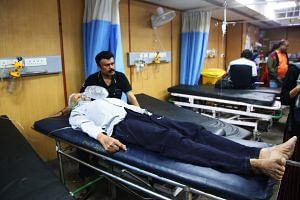
Breathing with the assistance of an oxygen mask, Baburaj feebly gestures that his condition has nothing to do with Delhi’s worsening AQI. But the doctor on duty explains that patients like him are the most vulnerable during peak pollution season.
“We as clinicians see trends emerging, like a sudden surge in illnesses with the rise in pollution. We can either crib about it or take action,” says Dr Desh Deepak, senior consultant at RML’s respiratory medicine department.
Also read:
Analysing impact
Everybody exposed to pollution is at risk, warns Shukla. “Many of the pollutants in the air are carcinogens. These pollutants enter not just the lungs but also the blood. They can have an impact on all the organs of the body. People who feel that they are healthy as they show no signs of acute illness may be affected in the long run,” he adds. Shukla warns of serious cell mutations in the next 10-15 years, which can potentially lead to the development of cancers.
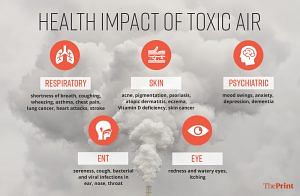
Keeping this as the central idea, doctors at the OPD will diligently analyse patients complaining of mood swings and aggravated anxiety, as well as those with skin disorders. People with complaints of sudden redness and irritation in the eyes and infections of the throat, nose and ears will also be categorised as patients impacted by pollution.
Psoriasis and atopic dermatitis – which flare up during winter season – are made worse by pollution, says Dr Kabir Sardana, director of and professor at RML’s dermatology department.
“Pollutants in the air cause permanent damage to the skin. They release certain compounds that cause ageing, pigmentation, acne and even cancers,” he explains.
Also read: Let states receive global capital. They can’t achieve net zero on their own
How toxic air affects mental health
RML’s psychiatry department is also working on drafting a standard operating procedure for assessing patients with mental illnesses potentially linked to pollution.
There is a growing body of evidence that shows the toll pollution takes on mental health. It can cause stress, depression, and even dementia.
“We think air pollutants go to the lungs and elsewhere, but these pollutants can also directly enter the brain from the nose,” says Dr Mina Chandra, head of the psychiatry department at RML Hospital. The department already has a template for research, but they “just need to make it friendly for clinical usage”.
While there are ample studies globally that demonstrate the long-term impact of pollution on health, such literature is missing from India. RML’s Department of Psychiatry, however, has been recording the impact of PM2.5 and ozone on mental health since 2018, in collaboration with the Indian Institute of Technology (IIT)-Delhi.
In a first of its kind paper published in 2022, doctors found a correlation between hospital admissions and rising levels of PM2.5, which is heavily laden with carbonaceous aerosols or atoms containing carbon.
In another paper published the same year, the authors analysed global studies assessing the impact of air pollution on cognition. They found that exposure to toxic air increases the risk of lower cognitive function among children and adolescents, causes cognitive impairment and decline among adults, and dementia among older adults.
‘Can’t wait for research’
India is a major polluting country, which is why the lack of India-specific research is a problem, says Chandra. Low and middle-income countries house around 40 per cent of the global population, but around 70 per cent of studies published between 2015 and 2019 were conducted in higher-income countries, she found.
According to Chandra and the co-authors of the 2022 paper on air pollution and cognitive outcomes, it is not certain that studies from high and upper-middle-income countries can be applied to nations like India. This is because there is a difference between quantities and sources of air pollution, which makes “the chemical composition of exposure, and subsequent health effects, unique”.
Doctors say they cannot wait for India-specific pollution studies to take action. Traditional OPDs must adapt to address health concerns related to a changing environment.
“We can’t keep sitting for 20 years for research to prove the linkages of pollution and diseases. We can draw references from studies done abroad. If we keep waiting for Indian studies, it will be too late. We have to act now,” says Sardana.
Meanwhile, doctors at the pollution clinic explain that once it picks up pace, the new OPD can also function as a research centre on pollution-related studies.
“The primary aim of the clinic is to serve the immediate needs of the people. But research would definitely be a byproduct. We would find out the questions that need to be answered through studies. But it takes time. As the problems come, we will find solutions,” says Deepak.
Also read: Quit stalling & pay up — what’s climate finance and why rich countries must step up urgently
Educating patients
Thirty-five-year-old Yasmeen has been camping on a footpath outside RML’s emergency ward since 24 October. Her husband, Mohammad Haseen, was put on ventilator support after his weak lungs gave in to increasing pollutants in the city’s air. But Yasmeen is unable to correlate her husband’s condition to Delhi’s hazardous AQI.
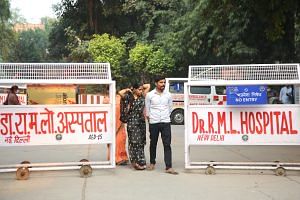
“His lungs were affected because he works at a welding shop. We rushed him to hospital last month after he had difficulty breathing,” she says.
At the pollution OPD, the doctors, besides providing treatment to patients, are also trying to change how they understand and perceive air pollution.
“People will realise the harmful effects of air pollution once they get affected by it. When they come to the clinic and we inform them that their problems are because of pollution, that is when the behavioural change will occur,” says Deepak.
(Edited by Zoya Bhatti)



